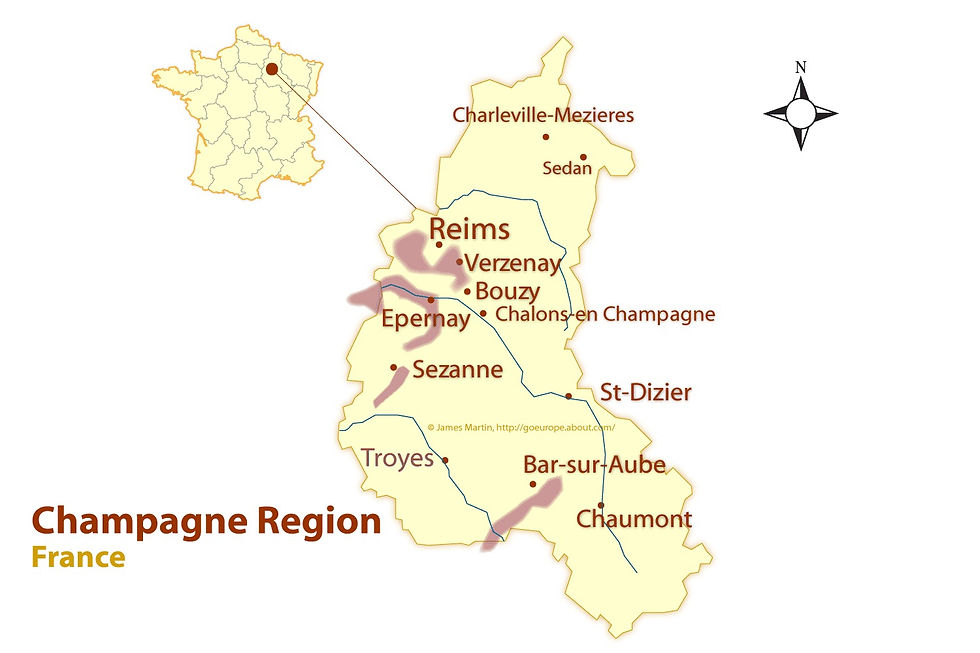
Being a Champagne lover it was natural that any trip to northern France would include a visit to Champagne! This blog is dedicated to Champagne lovers and it mentions the 3 main valleys in the province of Champagne (just east of Paris). It would however do the area a great dis-service if I didn’t mention that it is a stunning part of France. It is steeped in history with medieval castles and war sites from the WW1 Battles along the Marne River. The area has beautiful forests and quaint villages at every turn, and I would encourage you to make the Champagne Houses your destination, but make the beautiful villages and countryside of Champagne, the journey.
HISTORY: The Romans first planted grapes in the area and as Reims became a royal city it had a chance to showcase its wines (initially pale pink and flat).The nature of the climate caused many bottles to ferment in a different way and create bubbles that they spent hundreds of years trying to get rid of! Once the royal in England and France discovered these unique bubbles the industry had to work out how to stop the weak bottles exploding and then it was all go!
TIPS:
Every tourist office has maps of vineyard and cellars for its local area and Google has route maps which show all the vineyards on a route (like the one included). Some cellars are rather small, open limited hours and hard to find. Others are massive facilities with cellar tours at advertised times in English.
Many close over lunch, charge €5-8 for tasting (3-4 part glasses) and €12- 30 for a cellar tour (depending on how old and popular the cellar is)- so check out each of the individual websites to confirm costs and tour times in English. Some tours require advance booking in peak season.
September is harvest so very busy. Any time from May to October is lovely .
Here some French terms to know before you get started:
Vignobles: Vineyards. These are the “growers” Many do not make their own wine but are
a part of a co-operative and sell to the Champagne Houses. Many are not always open to the public.
Champagne Houses: These are the people who make the Champagne. They usual have “caves” or cellars- look for the old ones as these caves can be hundreds of years old and a visit of one is a must.
Caves: cellars
THE TRIP:
Some main towns: Champagne (pronounced Cham-parn-ya) , Reims (pronounced Rence) , Epernay (pronounced Ep-per- nay), Troyes (pronounced Twar)
The Champagne region is close to Paris and centred around Reims. You can easily catch the train to Reims and start from there. It is a lovely city worthy of a visit itself (The 13th century cathedral of Reims has sanctified the coronation of most of the French and the Romanesque Basilica of Saint-Rémi is exceptional).
Getting Around: A car is a must unless you want to join in one of the many day trips out of Epernay or Reims.
Routes: The Champagne wine growing region, has 100 main labels and 19,000 wine growers. There are amazing underground cellars and stunning chateaux. Champagne is divided into two main wine-producing regions: around Reims and Epernay in the north in the Marne, and around Troyes, the capital of the Aube region and the Cote des Bar to the south.In Reims, many cellars are on the Abbay St- Remi (250 kilometers of cellar with over 200 million bottles). In Epernay the Avenue de Champagne has several Champagne House side by side.
You could do all the 2 areas in a week (depending on how many of the hundreds of cellars you want to visit). Many people base themselves in Epernay, which allows you to visit each of the 3 valleys, as it is very central. If you are pushed for time Epernay is still the best base and Reims an easy nearby option.

OUR TOP 10 CELLARS:
I have listed the big well known ones but many “regulars” to the area insist that the best experiences come from one of the smaller family run Champagne houses. May you could try a mix of both if you have time
1. Moet & Chandon- Epernay. Probably the most famous of the champagne houses, and known for Dom Perignon.
1. Mercier- Epernay. Is one of the less expensive houses. The house has one of the largest barrels in the world, created in 1889 to hold 200,000 bottles for the Paris Exhibition.
2. Pommery- Reims is one of the largest and the most stunning. This is a favourite cellar if you only do 1 as you walk down 101 steps carved into the rock to the Gallo-Roman caves. There are 120 quarries here, storing between 23 and 25 million bottles.
3. Perrier Jouet -Epernay
4. Pol Roger -Epernay
5. Mumm-Reims
6. Louis Roederer- Reims
7. Tattinger-Reims
8. Veuve Clicquot- Reims. Off the main drag but a stunning walk down to the cellar.
9. Drappier – Troyes
10. Pannier- Chateau Thierry. Great medieval cellar plus a lovely town with an old castle 1200’s and a stunning WWI memorial to the battlefields of the Marne.
WEBSITES TO CHECK OUT:
Glass of Bubbly: https://www.glassofbubbly.com/10-great-champagne-houses-visit-2018/
Comments